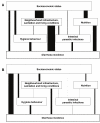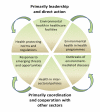Hygiene, sanitation, and water: forgotten foundations of health
- PMID: 21085694
- PMCID: PMC2976722
- DOI: 10.1371/journal.pmed.1000367
Hygiene, sanitation, and water: forgotten foundations of health
Abstract
As the first article in a four-part PLoS Medicine series on water and sanitation, Jamie Bartram and Sandy Cairncross argue that the massive burden of ill health associated with poor hygiene, sanitation, and water supply demands more attention from health professionals and policymakers.
Conflict of interest statement
SC leads a UK Department for International Development-funded research programme consortium for research in sanitation and hygiene.
Figures





References
-
- Prüss-Üstün A, Bos R, Gore F, Bartram J. Safer water, better health: costs, benefits and sustainability of interventions to protect and promote health. Geneva: World Health Organization; 2008.
-
- Guerrant RL, Kosek M, Lima AA, Lorntz B, Guyatt HL. Updating the DALYs for diarrhoeal disease. Trends Parasitol. 2002;18:191–193. - PubMed
-
- WHO and UNICEF. Progress on Sanitation and Drinking Water; 2010 update. 2010. Joint Monitoring Programme for Water Supply and Sanitation.
-
- WHO and UNICEF. Water Supply and Sanitation Global Assessment Year 2000 Report. 2000. Joint Monitoring Programme for Water Supply and Sanitation.
Publication types
MeSH terms
LinkOut - more resources
Full Text Sources
Research Materials

